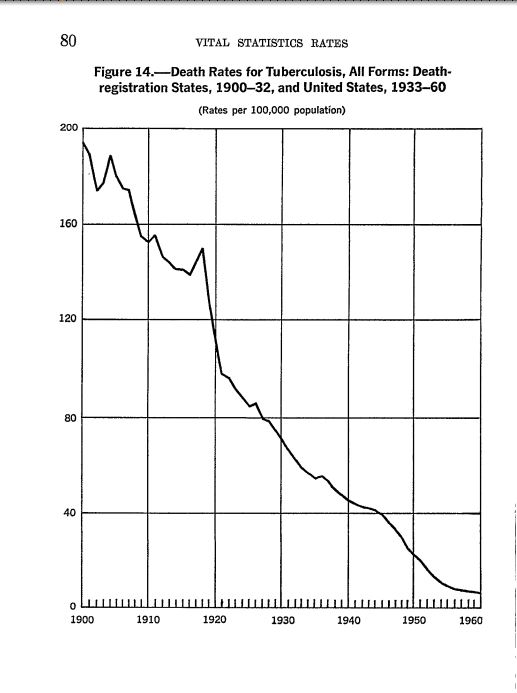All graphs sourced from –
VITAL STATISTICS RATES IN THE UNITED STATES
1940-1960
By Robert D. Grove, Ph. D.and Alice M. Hetzel
U.S. DEPARTMENT OF HEALTH, EDUCATION, AND WELFARE PUBLIC HEALTH SERVICE
Washington, D.C. 1968
National Center for Health Statistics
Click to access vsrates1940_60.pdf
Note – Graphs show death rates for diseases, preceded by the approximate date when vaccination for disease was widely instituted.
Diphtheria
Immunization for Diphtheria was incorporated with tetanus toxoid and pertussis vaccine and became routinely used in the 1940s.
Reference: http://www.cdc.gov/vaccines/pubs/pinkbook/downloads/dip.pdf

CDC on TB vaccination
Tuberculosis
BCG vaccination is not recommended as a routine strategy for TB control,
References: http://www.cdc.gov/mmwr/preview/mmwrhtml/00041047.htm
TB Vaccine (BCG)
Bacille Calmette-Guérin (BCG) is a vaccine for tuberculosis (TB) disease. This vaccine is not widely used in the United States, but it is often given to infants and small children in other countries where TB is common. BCG does not always protect people from getting TB. (emphasis mine)
References: http://www.cdc.gov/tb/topic/vaccines/

Typhoid
Immun Infekt. 1983 Jan;11(1):16-22.
[Typhoid vaccination yesterday and today].
Abstract
Despite the early attempts to produce resistance against typhoid fever with parenteral vaccination by Pfeiffer and Kolle in 1896, and with oral vaccines by Carroll in 1904, it was not until the 1950s when typhoid vaccine efficacy was prospectively evaluated in both well-controlled field trials and human volunteer studies. Among the parenteral whole cell preparations the acetone-inactivated and heat-phenol-killed vaccines, respectively, demonstrating an efficacy of 60-90% for 3-5 years, have received most attention. Oral killed typhoid vaccines have enjoyed popularity for many years, but their effectiveness has never been proven under statistically and epidemiologically controlled conditions
Reference: http://www.ncbi.nlm.nih.gov/pubmed/6341210

Measles
Measles vaccine introduced 1963
Achievements in Public Health, 1900-1999 Impact of Vaccines Universally Recommended for Children — United States, 1990-1998
Reference: http://www.cdc.gov/mmwr/preview/mmwrhtml/00056803.htm
Note – Measles vaccines were introduced in 1963 but coverage was low until the 1970’s.
1966-1970 Measles vaccine coverage among 1- to 4-year-old children did not exceed 63% for any year.
Reference: http://jid.oxfordjournals.org/content/189/Supplement_1/S17.long

Dysentery
No vaccine available
Note- decline parallels that of other infectious diseases, suggesting that other factors were responsible for fall in death rates.
